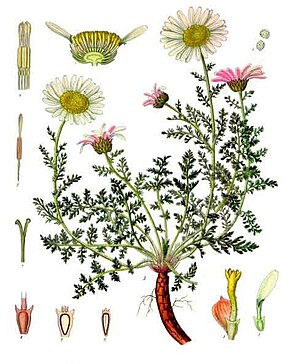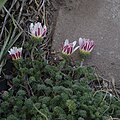Perennial Bertram
| Perennial Bertram | ||||||||||||
|---|---|---|---|---|---|---|---|---|---|---|---|---|

Perennial bertram ( Anacyclus pyrethrum ) |
||||||||||||
| Systematics | ||||||||||||
|
||||||||||||
| Scientific name | ||||||||||||
| Anacyclus pyrethrum | ||||||||||||
| ( L. ) Link |
The perennial Bertram ( Anacyclus pyrethrum (L.) Link ) is a species of marigold or Bertram ( Anacyclus ) and thus the sunflower family (Asteraceae).
features
The perennial bertram is a short-lived perennial herbaceous plant that is prostrate and thus only reaches heights of growth of 2 to 5 centimeters with a width of up to 40 centimeters. The species may form a taproot. The leaves are rosette, gray-green when young, twice pinnate, pressed to the ground and up to 10 centimeters long. The flower stem is prostrate and spread out like rays. The marginal ray-flowers are white, their underside is striped purple. The fruits are strongly compressed.
The flowering period extends from May to August.
Occurrence
The perennial Bertram occurs in south-east Spain, north Morocco and north Algeria on forest clearings and pastures at altitudes of 400 to 3100 meters.
Systematics
The species is rich in shape, two varieties have been described:
- Roman bertram ( Anacyclus pyrethrum var. Pyrethrum ): The shell has a diameter of 13 to 22 millimeters.
- Morocco-Bertram ( Anacyclus pyrethrum var. Depressus (Ball) Maire ): The shell has a diameter of 7 to 12 millimeters. This form occurs only in Morocco in the Atlas Mountains.
The German Bertram ( Anacyclus officinarum Hayne ), known only in culture, was possibly an annual descendant of the perennial Bertram.
ingredients
Pyrethrin (3% = two essential oils and resin), inulin (25–57.7%), tannin (0.55%), gum (9.40–20%), tannins (traces), iron (traces), Silica (0.95%).
use
The perennial bertram is widely used as an ornamental plant for rock gardens. In Germany it used to be used as a medicinal plant and liqueur spice. It has been in culture since 1930 at the latest.
The root is occasionally used as a spice and is considered a medicinal herb.
etymology
The designation of Anacyclus pyrethrum or Anacyclus officinarum as "Bertram" (Frühneuhochdeutsch berchtram , medium high German berhtram / Bertram ) is under alignment with the old German male name Berhtram derived from the Latin name of the plant pyrethrum (from the Greek pýrethron from pyr "fire") which is refers to the burning taste of the root of this plant (s), also called "fire root".
Common names
For the perennial Bertram, the names Beertrain ( Low German ), Berchthram ( Middle High German ), Berdram ( Middle Low German ), Bertrankrut (Middle Low German), Bertram , Bertrum , Brecht , Füerwöttel ( Mecklenburg ), Geiferwurz , St Johanniswurz , Spanish magdblum , Spanish meter , Metteren , Muterkraut , Perchtram , Perthram , Pertrem (Middle High German), Pertren (Middle High German), Perichtrawem ( Old High German ), marigold , salivary root and Zahnwurz commonly used.
history
swell
- Antiquity: Dioscurides 1st century --- Galen 2nd century
- Arab Middle Ages: Avicenna 11th century --- Constantine 11th century --- Circa instans 12th century --- Pseudo-Serapion 13th century
- Latin Middle Ages: Pseudo-Macer 11th century --- German Macer 13th century --- Hildegard von Bingen 12th century --- Herbarius Moguntinus 1484 --- Gart der Gesundheit 1485 --- Hortus sanitatis 1491
- Modern times: Hieronymus Bock 1539 --- Leonhart Fuchs 1543 --- Mattioli , Handsch, Camerarius 1586 --- Tabernaemontanus 1588 --- Nicolas Lémery 1699/1721 --- Onomatologia medica completa. 1755 --- Jean-Louis Alibert 1804/05 --- Jean-Louis Alibert 1826 --- Jonathan Pereira 1848 --- August Husemann , Theodor Husemann 1871 --- Theodor Husemann 1883 --- Hager's manual 1902
Historical illustrations
Pyrethrone. Vienna Dioscurides 6th century
Piretrum . Abdul ibn Butlan 14th century
Piretrum. Herbarius Moguntinus 1484
Piritrum. Garden of Health 1485
Piretrum. Hortus sanitatis 1491
Bertram . Leonhart Fuchs 1543
Bertram . Hieronymus Bock 1546
Mattioli / Handsch / Camerarius 1586
supporting documents
literature
- Eckehart J. Jäger, Friedrich Ebel, Peter Hanelt, Gerd K. Müller (eds.): Rothmaler excursion flora from Germany. Volume 5: Herbaceous ornamental and useful plants . Spectrum Academic Publishing House, Berlin Heidelberg 2008, ISBN 978-3-8274-0918-8 .
Individual evidence
- ↑ Anacyclus pyrethrum Anacyclus pyrethrum, Anthemis pyrethrum (both Roman Bertram); Anacyclus officinarum; Anthemis officinarum (both German). (PDF) Retrieved June 5, 2020 .
- ^ Friedrich Kluge , Alfred Götze : Etymological dictionary of the German language . 20th edition. Edited by Walther Mitzka . De Gruyter, Berlin / New York 1967; Reprint (“21st unchanged edition”) ibid 1975, ISBN 3-11-005709-3 , s. 68.
- ^ Georg August Pritzel , Carl Jessen : The German folk names of plants. New contribution to the German linguistic treasure. Philipp Cohen, Hannover 1882, page 25, online.
- ↑ Pedanios Dioscurides , 1st century, De Medicinali Materia libri quinque. Translation. Julius Berendes . Pedanius Dioscurides' medicine theory in 5 books. Enke, Stuttgart 1902, p. 311 (Book III, Chapter 78): Pyrethron (digitized version)
- ^ Galen , 2nd century, De simplicium medicamentorum temperamentis ac facultatibus. , Book VIII, Chapter XVI / 41 (after Kühn 1826, Vol. XII, p. 110): Pyrethrum (digitized)
- ↑ Avicenna , 11th century, Canon of Medicine . Translation and adaptation by Gerhard von Cremona , Arnaldus de Villanova and Andrea Alpago (1450–1521). Basel 1556, Volume II, Chapter 554: Piretrum (digitized version )
- ↑ Constantine the African , 11th century Liber de gradibus simplicium . Pressure. Opera . Basel 1536, p. 381: Pyrethrum (digitized version)
- ↑ Circa instans 12th century print. Venice 1497, sheet 205v: Piretrum (digitized)
- ^ Pseudo-Serapion 13th century, print. Venice 1497, sheet 152r (No CCCLVVI): Piretrum (digitized)
- ↑ Pseudo-Macer 11th century edition Ludwig Choulant. Macer floridus de virtutibus herbarum… Leipzig 1832, chapter 67: Pyrethrum (digitized version)
- ↑ Deutscher Macer 13th century. Schnell / Crossgrove 2003, chapter 79. Cpg 226 , Alsace, 1459–1469, sheet 204r: .lxxvj. Pjretrum is called berthram he is hot and print in the Vierden grade / when the zan meat wee dut of bad blood the kuwe bertram and hold the speckles long in the mouth that distributes the blood / it is also good against vil seeks in the mouth / Berthram Hanging on the children by the neck helps the falling searches / the smoke dauon also helps them / it is also consumed with honey tempered / Bertram jn oley boiled helps those who have the cold coated ee it jne on / the ointment spreads the loins jr vngemach with smeared / if you like swicz the smeared himself with the ointment he turns black / the same helps against manig seeks / it protects people from evil frost / it also helps against the food with smeared / one also penalizes with smeared and uses them looking for her there is called tetanus, the senadren are looking for when they are strict that you don’t like your neck (digitized)
- ↑ Hildegard von Bingen . 12th century Physica , Book I, Chapter 18: Bertram . Edition. Charles Victor Daremberg and Friedrich Anton Reuss (1810–1868). S. Hildegardis Abbatissae Subtilitatum Diversarum Naturarum Creaturarum Libri Novem. Migne, Paris 1855. Col. 1138 (digitized version) . Translation Portmann: Vom Bertram. The Bertram is of moderate and somewhat dry warmth, and this proper mixture is pure and has good freshness. For it is good to eat for a healthy person because it reduces the putrefaction in him and increases the good blood in him and prepares a clear mind in the person. But it also regains the strength of the sick, who has almost died in his body, and in humans he does not send anything out undigested, but rather prepares him for good digestion. And for a person who has a lot of phlegm in his head and (Bertram) eats a lot, he reduces the phlegm in his head. But also often enjoyed it drives the pleurisy out of people, and it prepares pure juices in people and makes their eyes clear. And in whatever way it is eaten, dry or in a dish, it is useful and good for both sick and healthy people. Because if a person eats it often, it drives away the disease from him and prevents him from getting sick. The fact that it creates moisture and saliva in the mouth when eating is because it pulls out the foul juices and restores health.
- ↑ Herbarius Moguntinus , Mainz 1484, Chapter 100: Piretrum (digitized version )
- ↑ Gart der Gesundheit . Mainz 1485, chapter 330: Piritrum bertram (digitized version )
- ^ Hortus sanitatis . Mainz 1491, Chapter 362: Piretrum (digitized version )
- ↑ Hieronymus Bock . New Kreütter Bůch . Strasbourg 1539, Part I, Chapter 153: Bertram (digital copy)
- ↑ Leonhart Fuchs . New Kreütterbuch… Basel 1543, Chapter 247: Bertram (digitized version)
- ^ Pietro Andrea Mattioli . Commentarii, in libros sex Pedacii Dioscoridis Anazarbei, de medica materia. Translation by Georg Handsch, edited by Joachim Camerarius the Younger , Johan Feyerabend, Franckfurt am Mayn 1586, sheet 271v – 273v: Bertram (digitized)
- ↑ Jacobus Theodorus . Neuw Kreuterbuch. Frankfurt 1588, pp. 368–371 (digitized version )
- ↑ Nicolas Lémery . Dictionnaire universel des drogues simples. Laurent d'Houry, Paris, 1699, pp. 635-636: Pyrethrum (digitized) . Translation. Complete material lexicon. Initially drafted in French, but now after the third edition, which has been enlarged by a large [...] edition, translated into high German / By Christoph Friedrich Richtern, [...]. Leipzig: Johann Friedrich Braun, 1721, Sp. 930-931 (digitized version )
- ^ Albrecht von Haller (editor). Onomatologia medica completa or Medicinisches Lexicon which explains all names and artificial words which are peculiar to the science of medicine and pharmacists art clearly and completely [...]. Gaumische Handlung, Ulm / Frankfurt am Main / Leipzig 1755, Sp. 1162: Pyrethrum (digitized)
- ^ Jean-Louis Alibert . Nouveaux éléments de thérapeutique et de matière médicale. Crapart, Paris 1804/05 (XIII), Vol. II, pp. 597-598: Pyrèthre (digitized version )
- ^ Jean-Louis Alibert. Nouveaux éléments de thérapeutique et de matière médicale. Crapart, Paris 5th edition 1826, Volume II, pp. 244–245 Pyrèthre (digitized version )
- ↑ Jonathan Pereira’s Handbook of Medicines Doctrine. From the point of view of the German Medicin edited by Rudolf Buchheim . Leopold Voß, Leipzig Volume II, 1848, pp. 420–421: Anacyclus pyrethrum, Bertramwurzel (digitized version )
- ↑ August Husemann , Theodor Husemann : The plant substances in chemical, physiological, pharmacological and toxicological terms. For doctors, pharmacists, chemists and pharmacologists. Springer, Berlin 1871, p. 947: Pyrethrum camphor (digitized) ; P. 1146: Pyrethrum, the essential oil (digitized version)
- ^ Theodor Husemann . Handbook of the entire pharmacology. Springer, Berlin 2nd edition 1883, pp. 217-218: Schmarotzermittel, Antiparasitica (digitized version) ; P. 563–564: Irritant drugs (digital copy )
- ↑ Hager's handbook of pharmaceutic practice for pharmacists, doctors, chemists and medicinal officials. Springer Berlin, 1902, Volume II, pp. 702–705 (digitized version )
- ↑ Herba piretri. In: Abdul ibn Butlan . Tacuinum sanitatis in medicina. 13th century, Codex Vindobon. Ser. Nova 2644, sheet 29v. Translation of the text by Franz Unterkircher. Tacuinum sanitatis ... Graz 2004, p. 72: Bertramkraut: Complexion warm and dry at the end of the first degree. Preferable: grown in the garden, fresh and tender. Use: it seasons cold dishes. Damage: it creates thirst and lies in the stomach for a long time. Prevention of harm: by celery. What it creates: pungent nutrients. Beneficial for people with a cold complexion, for old people, in winter and in cold areas.









